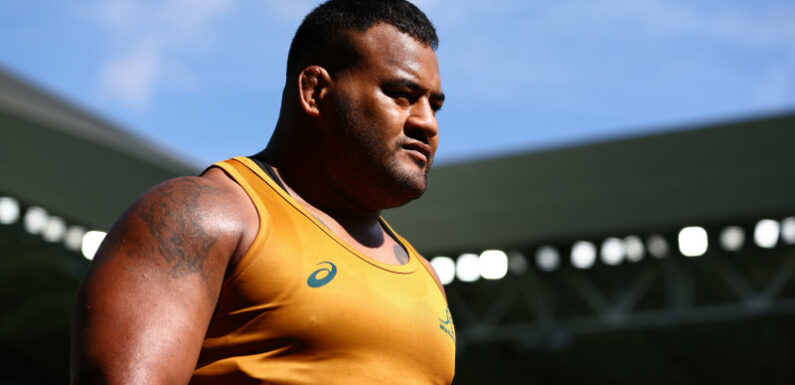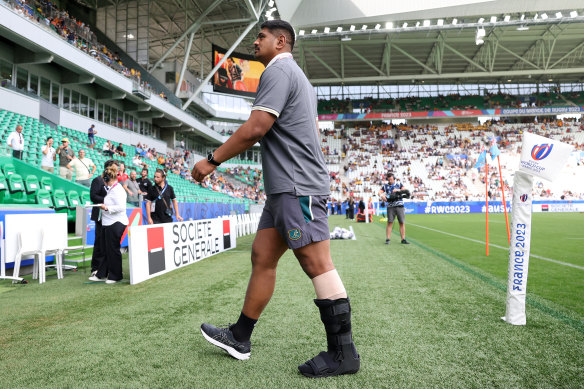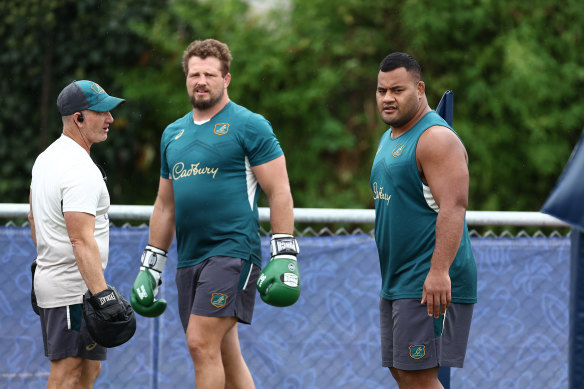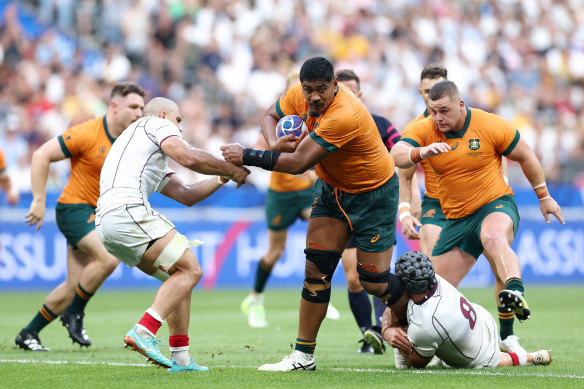
Save articles for later
Add articles to your saved list and come back to them any time.
It’s one thing going into a fight for your life, like the Wallabies will against Wales on Monday morning (AEST).
It’s quite another tying one arm behind your back and then going into a fight for your life, like the Wallabies will against Wales.
It got a bit lost in the shock and recrimination of the Wallabies’ defeat against Fiji but the losses of Taniela Tupou and Will Skelton to soft tissue injuries last week was a potentially fatal blow for Australia’s World Cup campaign.
Not just because Skelton is both the captain and the side’s best player, closely followed by Tupou. But also because Eddie Jones had finally settled on a “power” game strategy for the tournament, based heavily on the set-piece and carrying strength offered by the 275 kilogram duo.
Jones admitted on a podcast this week the currency to victory at this World Cup is the power of contact-zone behemoths, with the game now like a “mini NFL”, with 30-second bursts and 70-second stoppages.
Sure enough, without Skelton and Tupou, Fiji out-muscled the Wallabies and the inexperience of an undersized Australia did the rest.
Will Skelton walks in a moonboot ahead of Australia’s loss to Fiji in Saint-Eteinne.Credit: Getty
Neither will play against Wales, and given both are big men, they won’t be back before a quarter-final at the earliest – if Australia qualify. Jones says he is now working up new tactics.
So the question has to be asked: how did Skelton and Tupou succumb to soft tissue injuries at training? And more importantly, why does it keep happening in the Wallabies?
Since the start of the Wallabies’ Test season last year in June, injuries at training have piled up with abnormal regularity.
Some, like Max Jorgensen’s broken leg, fall into the unlucky category. The unfortunate reality of a contact sport, where training intensity must match game intensity to be successful. Mostly, concussions at training also fall into the category.
Taniela Tupou during a Wallabies training session at the Rugby World Cup.Credit: Getty
But soft tissue injuries are a different kettle of fish; a tear occurring usually when a muscle is weakened by overloading and overuse, or a previous injury, and often both.
Most sports teams have highly considered workload and training plans, and monitor players carefully to catch the potential for injury before it happens.
After the Wallabies suffered an enormous injury toll in 2022, where injuries affected 40 players – including an “alarming” four Achilles tendon injuries and multiple training-week incidents – Rugby Australia conducted an independent off-season review and issued new guidelines to ensure such a wasteful and expensive toll didn’t happen in a World Cup year.
And yet here we are again.
Along with another Achilles tendon injury to star tighthead prop Allan Alaalatoa in July (in-game but after a recent calf injury), the Wallabies have continued to see soft-tissue injuries at camps and in training, including Michael Hooper’s well-known calf tweak, which had huge consequences.
There are no absolutes when it comes to injury but most sports organisations will tell you soft-tissue injuries at training feel like an own-goal.
Training plans are finely balanced between the need to get players super fit and the need to not lose any with preventable injury. To keep your best players on the field.
Different coaches approach that balance in their own way. It is not uncommon for an old-school coach to ignore advice and push risk levels into the red by adding or extending brutal sessions, particularly after a loss.
Captain Will Skelton is tackled by Beka Gorgadze of Georgia during the Wallabies’ opening World Cup game.Credit: Getty
In Australian rugby, that risk level is always highest when players come out of Super Rugby and into the Wallabies, and because their fitness is considered woefully inadequate for Test rugby they get flogged for a few weeks. Without sufficient rest, multiple players often pick up injuries in this window.
And it’s been happening for a decade. Robbie Deans identified it as one of the biggest problems of Australia’s federated system, over a decade ago.
The numbers appear to be slightly fewer this year than last (the Wallabies generally don’t reveal injuries unless it affects selection for a Test) and informed sources say recommendations of the off-season medical review did carry through to Jones’ new coaching group.
But even with fewer casualties, the losses of Tupou and Skelton to soft-tissue injuries at training may as well be half the team. They are that important, particularly in a team where other experienced, contact-zone behemoths are few and far between.
Skelton’s workload bears scrutiny. Perhaps he declined the chance for a rest since joining the Wallabies in July, but it’s no secret the big unit had been going non-stop for almost a year. Since the start of the French season in September last year and getting injured last week, the 140kg lock played over 2000 minutes in 33 games – across Top 14, Champions Cup and Test rugby – and has continued to train intensively over the last two months.
“From all reports and from the evidence of two players having soft tissue injuries, he’s (Jones) over-trained them through the week,” former Wallabies winger Drew Mitchell said on The Good, The Bad and the Rugby Australia podcast.
“How can you have a hamstring and a calf [injuries] leading into the biggest game of our World Cup? There’s definitely an element of over-training for sure if you’re getting soft tissue injuries. There’s probably an indication that he [Jones] felt the pressure and has over-worked the guys.”
When all the postmortems come after this World Cup – and there will be a few – Rugby Australia would be wise to list “solutions to not break highly paid stars” as agenda item No.1.
Watch all the action from Rugby World Cup 2023 on the Home of Rugby, Stan Sport. Every match streaming ad-free, live and in 4K UHD with replays, mini matches and highlights available on demand.
Sports news, results and expert commentary. Sign up for our Sport newsletter.
Most Viewed in Sport
From our partners
Source: Read Full Article


